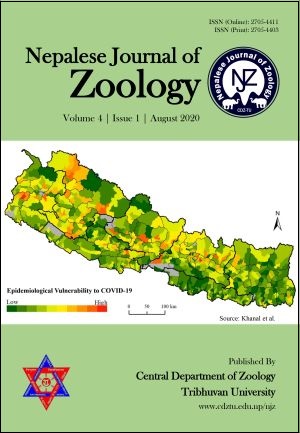Human-elephant conflict in the buffer zone of Chitwan National Park, Nepal
DOI:
https://doi.org/10.3126/njz.v4i1.30671Keywords:
Crop Damage, Elephas maximus, Human casualty, Perception, Seasonal patternAbstract
The interaction between human and wildlife sharing same resources often result negative outcomes and are referred as the human wildlife conflict which affects not only humans but also the wild species. Such conflicts, especially from the mega-herbivores such as elephants has become one of the major management challenges for the Chitwan National Park (CNP), Nepal. Spatial and temporal patterns of human elephant conflict (HEC) in the buffer zone of CNP were analyzed using park data and questionnaire survey conducted among three hundred and ninety residents of thirteen buffer zone user committees (BZUC) within Chitwan district from October 2016 to May 2017. Five hundred and forty-three HEC incidents including three human deaths and two human injuries were reported in BZUC from January 2013 to April 2017. Crop damage was found to be the most common type of damage caused by elephants and were higher during post-monsoon. Property damage incidents were higher during the winter season. There was a negative association between the number of HEC incidents and distance from the forest edge of the national park. However, no significant relation of HEC incidents was observed with average monthly temperature and rainfall. Despite of increasing HEC incidents, majority of people (77%) had positive attitude towards elephant conservation and considered elephants as nation’s treasure.
Downloads
Downloads
Published
How to Cite
Issue
Section
License
This license enables reusers to distribute, remix, adapt, and build upon the material in any medium or format for noncommercial purposes only, and only so long as attribution is given to the creator.

